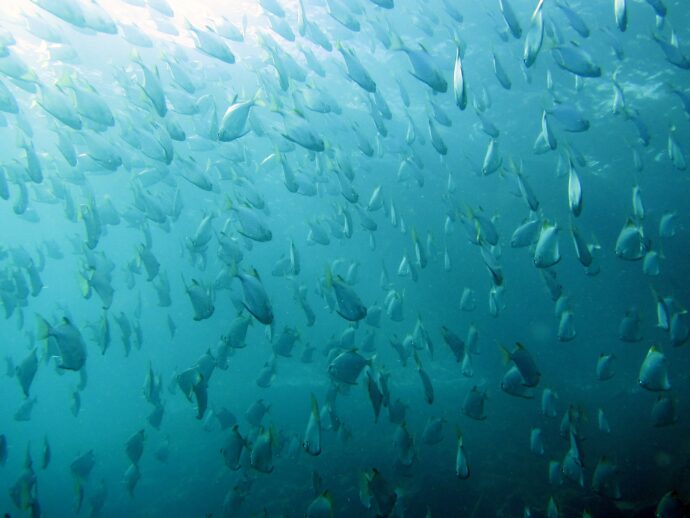
As COVID-19 continues to disrupt our lives, many of us are turning to home cooking for health and entertainment. I’m working on my thin-crust pizza, and many of my friends are calling me at odd hours to ask for advice on preparing unusual delicacies.
Yet no one has called to ask me how to bard a pigeon (wrap it in bacon tied with butcher’s twine). Two centuries ago, passenger pigeon was the star of the dinner table across most of North America. It was stewed, roasted, served up in pies, and yes, barded.
But passenger pigeons aren’t remembered for their tasty (if dry) meat. They are remembered as the most famous culinary extinction of all time. Overharvested to the point of collapse, the passenger pigeon is a stern warning as we struggle to manage the culinary wealth of our ecosystems.
When they were as free as a bird
The passenger pigeon was a striking bird. The males were over 30 centimetres (nearly a foot) long and mottled with patches of copper, blue, grey, and purple. Both sexes shared a gentle calling pattern, once known to everyone living west of the Rockies but which no living person has ever heard. But what set them apart was their flocking.
There were once five billion passenger pigeons, migrating together in a great circle from the Southern States to the Canadian Arctic, flying at 50 miles (80 km) per hour. The great flocks would block the sun for days as they travelled overhead. They stopped only to raise their young in huge roosts covering hundreds of square kilometers. Then, having exhausted their food supplies, they had to move on.
Alexander Wilson studied the birds in Kentucky, and in 1810 described them as a “living darkness, a loud rushing wind similar to a tornado.” John Audubon described a three-day dusk as the birds passed overhead along the Ohio River in 1813, blocking the sky as they passed just over his head. He wrote, “the air was literally filled with pigeons; the light of noonday was obscured as by an eclipse.”
Why they became rare birds
Unfortunately for the passenger pigeon, they were both tasty and very easy to catch. Indigenous peoples hunted them yet were careful never to kill young birds. At first, Europeans didn’t dent the great flocks either, but as the population of North America grew and technology improved, we quickly overwhelmed the ability of the passenger pigeon to hatch enough chicks to replace the missing birds. The development of railways and the invention of the telegraph allowed hunters to follow the flocks, kill hundreds of thousands of pigeons, and ship them to great cities of the East.
Young, tender birds were particularly valued in high society. Charles Ranhofer, head chef at New York’s most storied restaurant, Delmonico’s, served them stuffed with ham and truffles. He also cooked them with pork, mirepoix, and cock’s comb, surrounded by crawfish and foie gras. As the birds became rare, New York’s elite continued to dine on pigeons with peas, pigeon pie, and pigeons fricasseed in wine reduction. In 1893, the last bird sold at Fulton Market commanded a great premium.
And then there were none
The final demise of the species was still a shock. Although the first endangered species laws in the United States were crafted to protect the passenger pigeon, and zoos rushed to breed them in captivity, the remaining flock dwindled until only a single bird remained. Named Martha, she lived for four lonely years in the Cincinnati zoo as the last of her kind. When she died in the afternoon of September 1, 1914, a horrible milestone was reached. For the first time in human history we watched a species die.
Plenty of fish in the sea?
Oceanic extinction rates are much lower than terrestrial extinction rates. Over the last 500 years, only 3 percent of extinctions have been oceanic. The oceans are larger, occupying more than 70 percent of the Earth’s surface. More importantly, we haven’t been technologically able to access the ocean in the same way as terrestrial biomes until very recently.
Not so much for cod
In the summer of 1992, after 500 years of fishing, the Northern Cod population fell to 1 percent of historic levels. Whole towns were thrown out of work as the federal government declared a moratorium on fishing, and the species that was so much a keystone of Newfoundland life that it was simply referred to as “fish” was off the menu.
Tuna no more?
Like cod, the Atlantic Bluefin Tuna is also facing the threat of extinction. A wild apex predator, this glorious tuna can reach more than 725 kilograms (1,600 pounds). Sports fishermen in North America have long prized the Atlantic Bluefin, yet for years sold their catch as pet food.
However, frequent international flights and Styrofoam packing crates allowed fish to be flown to Japan, where Bluefin tuna command fabulous prices. Prized for sushi and sashimi, high demand has devastated the stocks of this massive fish, which are down 70 percent in the Eastern Atlantic and 80 percent in the Western Atlantic.
As the species is so valuable, there has been global cooperation to limit the catch, but with little success. The United Nations has rejected a US-led ban on Bluefin Tuna fishing and trading, largely due to opposition from Japan.
I’m an optimist. I believe we can be more thoughtful about what we eat and the stress we put on the natural world. I love Bluefin tuna, but I don’t eat it anymore. It’s too late for the passenger pigeon, but we can make a difference every day, at every meal.
What can we do?
As thoughtful consumers, we can make choices that greatly reduce the potential for further culinary extinctions.
- We can choose diets lighter in animal protein. Seventy percent of the Earth’s agricultural land is used to produce meat, and our hunger is driving deforestation and land degradation around the world.
- We should eat fish less often, and when we do, we should buy Ocean Wise.
- We should also eat lower on the food chain. Large predators, such as the Atlantic Bluefin, are few in number and slow to reproduce.
- We can choose sustainably harvested shrimp, a much better choice.
How to consume fish conscientiously
Learn more about Ocean Wise, (seafood.ocean.org) a conservation program that tackles overfishing and combats maritime habitat damage. Their labelling program helps consumers make sustainable seafood choices.







